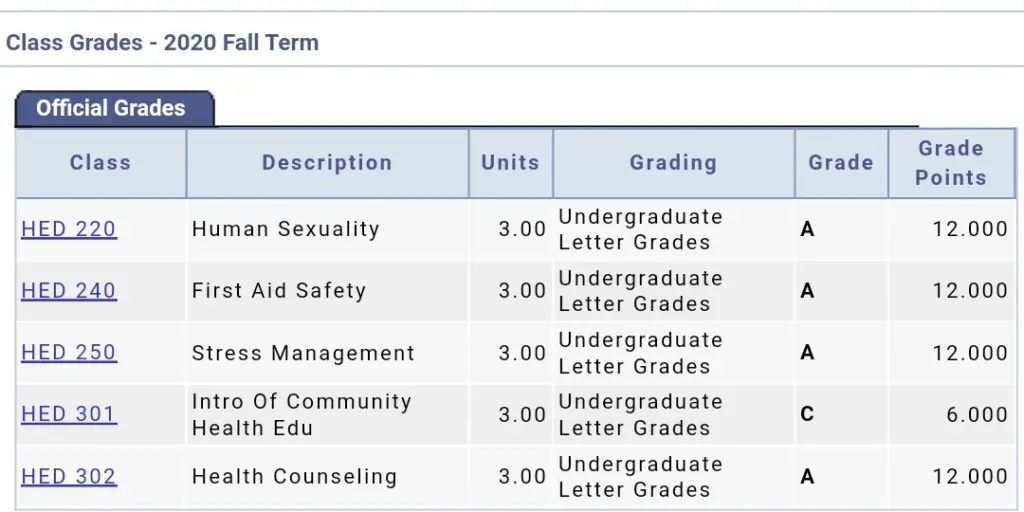Passing a class is the main goal of any student. Understanding your current standing in the course and what it takes to secure a passing grade is super important.
It doesn’t matter if you’re approaching the end of the semester or just want to stay on top of your academic progress. Calculating the grade you need to pass a class can provide valuable insights and help you strategize your efforts effectively.
Understanding how to calculate grades can be confusing at times, so let’s explore the process of determining the grade you need to pass a class in detail. We will also offer some practical tips to ensure your success.
Step 1: Understand the Grading System

Before delving into calculations, it’s essential to familiarize yourself with the grading system used in your class. Different educational institutions and instructors may use various grading scales, such as letter grades (A, B, C, D, F), percentages, or a point-based system.
Additionally, some classes may have a pass/fail grading system. Ensure you know which system applies to your course, as this will influence your calculations.
Step 2: Gather Your Current Grades
To calculate the grade you need to pass a class, you must start by assessing your current performance. Collect all your graded assignments, tests, quizzes, and other assessments. You should also include any extra credit points or bonus marks you’ve earned, as these can impact your final grade.
Step 3: Determine the Weight of Each Grade Component
Most courses are divided into various components, each carrying a specific weight in your overall grade. Common components include homework assignments, quizzes, midterms, finals, projects, and participation. Understanding the weight assigned to each component is crucial for calculating the grade you need to pass the class.
Step 4: Calculate Your Current Grade
Now that you have your grades and their respective weights, you can calculate your current grade in the class. Follow these steps:
1. Assign a numerical value to each letter grade based on the grading scale used in your class. For example:
- A = 4.0
- B = 3.0
- C = 2.0
- D = 1.0
- F = 0.0
2. Multiply each of your grades by their corresponding weight. For instance, if you have a B (3.0) in a component worth 20%, you would multiply 3.0 by 0.20 to get 0.60.
3. Sum up all these weighted values to determine your current total grade points.
Also Read – How to Efficiently Engage Students in a Hybrid Classroom
Step 5: Set Your Passing Grade Target
The passing grade varies from one institution to another and can also depend on specific course requirements. Typically, passing grades are represented as letter grades (e.g., C or higher) or as a percentage (e.g., 70% or higher). To calculate the grade you need to pass, you should know the minimum requirement for your class. For example, if a C (2.0) is considered a passing grade, you’ll use 2.0 as your target grade point average.
Step 6: Calculate the Remaining Grade Needed
To find out what grade you need on the remaining assignments or exams to pass the class, use the following formula:
- Passing Grade: This is the minimum grade required to pass the class (e.g., 2.0 for a C).
- Current Total Grade Points: The total grade points you’ve earned so far, as calculated in step 4.
- Remaining Weight in the Course: The combined weight of all the remaining assessments that will contribute to your final grade.
Step 7: Plan Your Approach
Once you’ve calculated the remaining grade needed, it’s time to develop a strategy for achieving that grade. Here are some tips to help you succeed:
1. Prioritize Your Assignments: Focus on assignments, tests, or exams with the most significant weight in the course. These will have the most significant impact on your final grade.
2. Seek Help if Needed: If you’re struggling with the course material, don’t hesitate to reach out to your instructor, a tutor, or a study group for assistance.
3. Create a Study Schedule: Plan your study sessions and allocate more time to subjects or topics where you need improvement.
4. Stay Organized: Keep track of assignment due dates, exam schedules, and your progress toward your target grade.
5. Stay Motivated: Remind yourself of your goal to pass the class and the benefits of achieving it.
Step 8: Monitor Your Progress
Regularly update your grades and recalculate your remaining grade needed as you complete assignments and assessments. This will help you stay on track and adjust your efforts if necessary.
Step 9: Don’t Forget Extra Credit
If your class offers extra credit opportunities, take advantage of them. Even a few extra points can make a significant difference in reaching your passing grade.
Step 10: Stay Persistent
Passing a class might require hard work and dedication, especially if you started with a lower grade. Stay persistent, stay focused on your goal, and keep putting in your best effort until the end of the semester.
FREQUENTLY ASKED QUESTIONS
1. What is a Passing Grade?
A passing grade is the minimum grade required to successfully complete a course. It varies depending on the institution and the course’s specific requirements.
Common passing grades are C or higher (on a letter grading scale) or a percentage equivalent, often around 70% or higher. It’s essential to check your course syllabus or consult your instructor to determine the passing grade for your class.
2. Can I Still Pass if I’ve Earned Low Grades Earlier in the Semester?
Yes, it is possible to pass a class even if you’ve earned low grades earlier in the semester. Your overall grade is based on the weighted average of all your assignments and assessments.
By performing well on remaining assignments and exams, you can improve your grade and reach the passing threshold. It’s essential to calculate the grade you need to pass and plan accordingly.
3. How Can I Use Extra Credit to Improve My Grade?
Extra credit opportunities, if available, can be used to boost your grade. Since they are often offered as additional points, they can help you reach the passing grade more easily.
To utilize extra credit effectively, complete these assignments or tasks to the best of your ability and submit them on time. Always check with your instructor for specific guidelines on earning extra credit.
4. Is It Possible to Pass a Class If I’ve Missed Some Assignments or Tests?
Missing assignments or tests can make passing a class more challenging, but it is still possible. Focus on performing well in the remaining assessments, as they carry the most weight in your final grade calculation.
Additionally, communicate with your instructor to see if there are any options for making up missed work or if there are any alternative assignments available.
5. What Should I Do If I’m Unsure About My Current Grade?
If you are unsure about your current grade in a class, don’t hesitate to reach out to your instructor. They can provide you with your current grade or offer guidance on how to calculate it accurately.
Additionally, most educational institutions have systems or portals where you can track your grades and academic progress, so make use of those resources to stay informed.
Conclusion
One of the underrated skills of student life is calculating the grades you need to pass a class. This brings you one step closer to taking control of your academic success. By understanding the grading system, assessing your current grades, and setting a clear passing grade target, you can create a roadmap to academic success.










